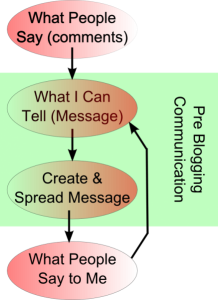Do most executives understand the use the advantages of blogs?
How is the shift from traditional communication between companies and their customers changing executive behavior?
Is blogging going to become a preferred format in corporate board rooms?
Should the average executive learn, test and practice blog and social media use?
If executives take a wait and see attitude, are they losing something?

When I explain to an executive about blogs I cover only basic concepts. Explaining how blogs differ from traditional Internet communication goes like this:
- Blogs are informal and open two-way communication format. Traditional web sites are more formal and unidirectional communication format.
- The basic concept of informal and more open communication with your audience is easy to explain. Writing to your audience at the right level (style, jargon) makes sense to executives.
- Next comes the two-way communication using reader comments. Getting people to comment on your message makes even more sense. Adopting a better way to speak on the Internet also makes sense.
It takes time and seeing some results for most executives to be convinced on the actual effectiveness of blogs. Seeing the difference between static web sites and blogs, real tangible results, may take time and trial and error. In today’s desire for immediate results, this is a challenge we need to address. Combine the need to show immediate results with a little suspicion about the effectiveness of blogs and it is harder to convince executives to try blogging. Trying something new takes trust. Not just the trust in the blog format, but trust in the big change in how we communicate. In blogs you need to trust in telling your audience the good, bad, pretty and ugly. The bad and ugly parts are not things we talk about usually. This is where most executives have a hard time getting the idea. “Why tell potential customers that there is anything bad in our product?” Before blogs came along, your self-image was always positive (good, pretty, nice, happy.) With blogs you need to be more real and balanced. You need to show the negative side. The same two issues apply when trying to convince executives on giving total strangers the ability to comment openly to your articles (seeing immediate results and believing in effectiveness of blogs.) Comments on your articles are going to be both positive and negative. Good comments are fine, bad ones, executives don’t like. But here lies the power of a blog, everyone can see the “bad” (negative) comments. This is feedback, it makes two-way communication useful, even critical. Two-way communication is not just useful to company executives. It is more useful to new readers, the ones who are going to be your future customers. Outsiders, looking at your responses, want to see how you respond to them. If negative feedback is real and you take it as constructive criticism, you got the benefit of improving your product, improving your service, and satisfying your customers. This will increase the trust of your current customers and show potential customers that you are serious about listening to them and will do something about their problems. Is this too simple of an explanation? Not from my experience. Everyone understands, but until they see it in action, they are still not 100% convinced. (Seth Godin calls this behavior “the lizard brain”)
So what’s so hard about asking for feedback on a blog and using it? I think it’s the mindset of not trying to convince someone in a slick message that your product is the “best, cheapest or newest” . Instead of “presenting” in front of an audience you are having a “conversation” with them.Take a meeting analogy as an example: meetings and presentations are tools of the trade in business: you use a Power Point presentation, stand as an authority and tell the audience how great your product is. Now take a face to face meeting analogy as an example: you are sitting and talking face to face with a printed page or pencil and paper. You are making the same point but having a conversation. This is another way to explain the difference between a traditional website and a blog. A traditional web site is the presentation, a blog is the face to face meeting. This is a big change to the way we try to convince people to listen to us. It took most companies ten years to make their website beautiful. Now you want to add not so beautiful comments and even write about things that don’t really work as they should? It is hard to change someone who learned how to present in front of people with a slick marketing presentation to someone who has to sit down and have a conversation. Once someone understands this analogy, they need to get over their objections: What if the readers are not happy with my product? or are frustrated with my customer service people? It is harder to sit in a meeting with people who may criticize your product or simply not believe in what you say. Experienced executives have been in situations where someone criticizes them or simply does not listen. This is what I referred to earlier as unidirectional communication going bidirectional. Some sales people say that listening to people is the hardest skill to master and the most useful one to succeed. Most people can’t just sit and listen. It is not something that most executives do in their daily life. It is not something they like to do. That is why they are isolated from angry customers, even ones that can help them improve. They use sales and customer support people to do the hard work. Lawyers and psychologists are good at listening. Policemen and teachers less good at it.
If you are going to have a conversation instead of a presentation, than you need to change the message. Actually change the way you create a message, deliver it and use feedback. When creating the message, it is no longer slick and convincing, now it’s direct, simple and honest. If your product does not have all the features of the competitors, don’t hide this. If you are good at certain things but not others, say it. If you are just in the early stages of the product development and more features are coming, be clear about when and how. Ask open-ended questions and listen carefully to the answers. Get more specific answers by asking for clarification. Many companies are doing this with their new products and it works. Take a look at all the blogs on the iPhone and Kindle. Lots of positive review but also negative ones. Apple and Amazon are not shy to give customers the bad news about current models. One point that is important to make is: “it’s going get better, and soon, so tell us what you really think.” If you want the product as it is now, that’s fine, some features are not perfect. You can enjoy the things that work. If you want more features, a better price or just want to wait, that’s fine with us. Use these two examples with most people and they clearly understand.
Back to the executive attitude towards blogging. How do we help executives understand and use blogs? There are a few approaches. One is to explain in detail and show examples. The ideas are not complicated and make sense to anyone who understands communication with customers. Executives who are more concerned with other elements such as finance and return on investment (ROI) need to see the results in their language. Another way is to deploy small pilot programs and show results on a small-scale. Pilot programs take time and effort but do not require a large investment in resources. Think of a small-scale model of a big blog. The drawback of small-scale models is the difference from the real thing. If a small blog works, a big one can take much longer and need more resources than just multiplying a small one many times. This can be shown with examples from large companies. Take for example ten Microsoft blogs on Office™ may not be as useful as a hundred blogs on ten other applications like SQL-Server™, One note™, Project™ or X-Box™. What works in one place does not work everywhere. Some executives like to see experts brought in. Bring into your company people who have done big blogs in other places. There are blog managers who have done this, freelancers who are interested in working at companies and lower level experts who want to move up in responsibility. Today, blog management and creation is becoming a standard (professional) job title. Some executives want their people to learn new skills. So bring in experts to bootstrap and train. There are many ways to do this, as Nike says: Just Do IT!
I do not have many resources on demonstrating blog efficiency to executives, that would be my next series of articles (ROI, management, control.)
Ami Vider

